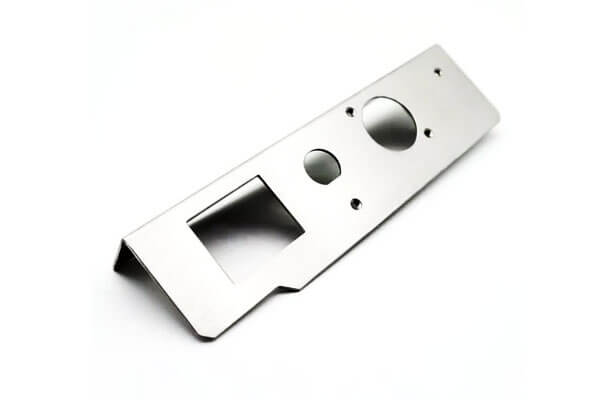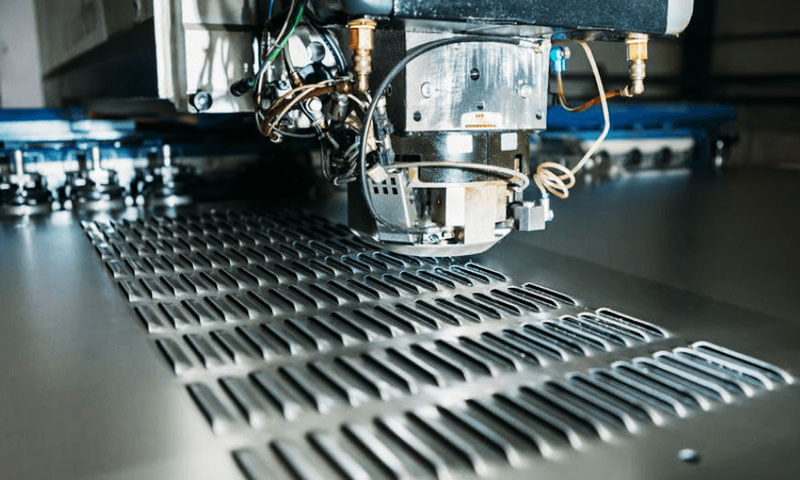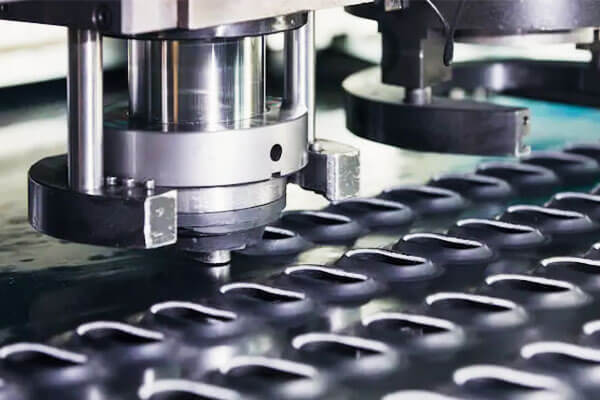1. Introduction
Metal stamping is a manufacturing process that forms, cuts, and shapes metal sheets into precise components.
This method plays a critical role in modern production, driving innovation in industries such as automotive, aerospace, electronics, and household appliances.
Manufacturers rely on metal stamping to produce consistent, high-quality parts at high volumes, which makes it indispensable in today’s competitive market.
In this article, we will explore the fundamentals of metal stamping, discuss various stamping processes and materials,
analyze its key advantages and limitations, and examine its diverse applications and future trends.
By understanding these aspects, manufacturers can make informed decisions to optimize production and drive innovation.
2. What Is Metal Stamping?
Metal stamping transforms flat metal sheets into complex components using presses, dies, and various forming techniques.
The process applies tremendous pressure to a metal sheet placed between a die and a punch, permanently deforming the metal into the desired shape.
This method relies on the precise control of force and pressure to achieve high-quality results.
Common operations in metal stamping include:
- Blanking: Cutting a flat piece (blank) from a larger metal sheet. This process removes excess material, forming a precise shape that serves as the starting point for further operations.
Metal Stamping Blanking - Punching: Creating holes or specific shapes by driving a punch through the metal. This method is often used for forming apertures, slots, or patterns in the workpiece.
Metal Stamping Punching - Bending: Deforming the metal along a defined axis to create angles or curves. Bending is critical for fabricating components with precise contours.
- Embossing: Raising or recessing a design on the metal surface by applying pressure with a patterned die. This enhances both the aesthetics and functional properties of the part.
metal stamping embossing - Coining: Imprinting fine details onto the surface under high pressure. Coining is used to create intricate textures and precise geometries in critical applications.
- Flanging: Bending the edge of a metal sheet to form a flange, which adds strength and facilitates assembly.
3. Types of Metal Stamping Processes
Metal stamping processes play a crucial role in modern manufacturing by transforming flat metal sheets into complex, high-precision components.
Below are the primary types of metal stamping processes, each tailored to meet specific design and production needs.
Progressive Die Stamping
Progressive die stamping is a continuous process that uses a series of interconnected dies.
As a metal strip moves through the press, each station performs a distinct operation, such as punching, blanking, or forming. This method is highly efficient for high-volume production.
Advantages:
- Capable of producing thousands of parts per hour.
- Excellent for complex, multi-step operations on a continuous strip.
- Consistent quality with tight tolerances.
Transfer Die Stamping
In transfer die stamping, the workpiece transfers between separate presses, with each press performing a specific operation.
This process suits parts that require multiple, sequential forming actions.
Advantages:
- Ideal for complex parts with several forming stages.
- Allows precise control over each operation, ensuring high-quality results.
Four-Slide Stamping
Four-slide stamping employs four independently moving slides that act simultaneously to shape the metal. This process enables the creation of intricate bends and forms in a single press cycle.
Advantages:
- Produces parts with multiple bends and curves with high accuracy.
- Particularly effective for automotive and appliance components where complex geometry is required.
Deep Drawing
Deep drawing pulls a metal sheet into a die cavity to form deep, hollow shapes. This process is essential for creating components like fuel tanks, kitchen sinks, and automotive body panels.
Advantages:
- Excellent for producing seamless, high-integrity parts with significant depth.
- Allows for uniform thickness distribution across the drawn part.
Challenges:
- Requires careful control to prevent tearing or wrinkling, particularly in materials with lower ductility.
Fine Blanking
Fine blanking is a high-precision stamping process that achieves excellent surface finish and tight dimensional tolerances.
This method uses specially designed dies to produce parts with smooth edges and intricate details.
Advantages:
- Produces parts with near-mirror finishes, minimizing the need for secondary processing.
- Ideal for critical components such as gears and intricate mechanical parts.
4. Materials Used in Metal Stamping
Metal stamping relies heavily on the selection of the right materials to ensure that the final parts meet stringent quality and performance requirements.
Different metals and alloys offer unique properties such as strength, ductility, corrosion resistance, and conductivity.
which directly influence the stamping process and the characteristics of the stamped components.
In this article, we delve into the common materials used in metal stamping, their key properties, and how they are selected based on application-specific needs.
4.1 Metals Commonly Used in Stamping
Steel
Steel remains the backbone of metal stamping due to its versatility and robust properties. Various forms of steel are used:
- Carbon Steel:
Carbon steel offers high strength and excellent formability. It is widely used for automotive components, structural parts, and industrial machinery.
Its relatively low cost and availability make it a popular choice for high-volume production. - Stainless Steel:
Known for its corrosion resistance and durability, stainless steel is essential in applications where hygiene and longevity are critical, such as in medical devices and food processing equipment.
Laser or fine blanking techniques often produce high-quality edges with stainless steel. - Galvanized Steel:
Galvanized steel features a protective zinc coating that prevents corrosion, making it ideal for outdoor applications and appliances.
In stamping, it requires careful handling to maintain the coating integrity during forming.
Aluminum
Aluminum is prized for its lightweight and corrosion-resistant properties.
Its excellent formability enables the production of intricate designs, particularly in the aerospace and consumer electronics industries.

Aluminum stamping often results in parts that contribute to overall weight reduction in vehicles and aircraft, leading to improved fuel efficiency and performance.
However, its lower strength compared to steel necessitates design optimization to ensure structural integrity.
Copper and Brass
Copper and brass provide excellent electrical conductivity and thermal performance.
These metals are commonly used in the electronics and electrical industries for components like connectors, switches, and circuit board housings.

Their inherent malleability allows for precise stamping operations, although cost and work hardening may limit their use in high-stress applications.
Titanium
Titanium offers a high strength-to-weight ratio, remarkable corrosion resistance, and the ability to withstand high temperatures.
Although more expensive, titanium is frequently employed in aerospace, medical implants, and high-performance sports equipment where weight savings and durability are paramount.
Metal stamping with titanium requires specialized techniques due to its high cost and challenging formability characteristics.
4.2 Factors Affecting Material Selection
Manufacturers consider several key factors when selecting materials for metal stamping:
Strength and Durability:
The material must withstand the stresses encountered during stamping and in the final application.
For instance, automotive structural components require high-strength steel, while aerospace parts may favor lightweight aluminum or titanium.
Ductility and Formability:
Materials must be sufficiently ductile to undergo plastic deformation without cracking.
High ductility is critical in deep drawing processes to ensure even thickness distribution and prevent wrinkles or tears.
Corrosion Resistance:
The operating environment significantly influences material choice.
Stainless steel or galvanized steel might be preferred for outdoor applications, whereas aluminum is often selected for its natural corrosion resistance.
Conductivity:
In electronics and electrical applications, metals like copper and brass are chosen for their superior electrical conductivity.
Cost-Effectiveness:
Balancing performance with cost is essential. While high-performance alloys like titanium offer excellent properties,
their cost may be prohibitive for high-volume production compared to more economical materials like carbon steel.
5. Key Advantages of Metal Stamping
Metal stamping offers several compelling benefits that have established it as a core manufacturing method:
High-Speed Production
Metal stamping produces thousands of parts per hour, making it one of the fastest production methods available.
For instance, large automotive plants can stamp out tens of thousands of body panels every month, reducing lead times and accelerating time-to-market.
Cost-Effective for Large Runs
While the initial tooling investment is high, the per-unit cost drops dramatically with large production volumes.
Economies of scale make metal stamping especially attractive for mass production, lowering overall manufacturing costs significantly.
Consistency and Precision
The stamping process consistently produces high-quality, uniform components with tight tolerances.
This consistency is crucial in sectors such as aerospace and electronics, where even minor deviations can affect performance and safety.
Wide Material Compatibility
Metal stamping works with a variety of metals and alloys, providing manufacturers the flexibility to choose the most suitable material for each application.
This versatility extends the range of products that can be efficiently produced.
Integration with Automation
Modern stamping processes integrate seamlessly with automated systems and robotics.
This integration enhances production efficiency, reduces labor costs, and minimizes human error, leading to greater throughput and improved product quality.
6. Limitations and Challenges of Metal Stamping
Despite its advantages, metal stamping also has notable challenges:
High Initial Tooling Cost
Developing and manufacturing precise dies and stamping presses require significant capital investment.
Although cost-effective for large runs, these high upfront costs can be a barrier for low-volume or custom production.
Limited Design Flexibility
Metal stamping excels in producing standard parts but may not offer the design flexibility needed for highly intricate or variable components.
The fixed nature of dies restricts modifications without significant retooling costs.
Material Thickness Constraints
The process is best suited for thin to medium-thickness metal sheets.
Processing very thick or hard metals poses challenges and can lead to increased scrap or the need for alternative manufacturing methods.
Risk of Material Waste
Complex geometries can result in higher scrap generation. While optimized nesting software can reduce waste, the inherent limitations of stamping may still lead to material inefficiencies, especially in intricate designs.
Maintenance and Downtime
Stamping presses and dies require regular maintenance to ensure quality and consistency.
Frequent downtime for repairs or recalibration can disrupt production schedules and impact overall efficiency.
7. Applications of Metal Stamping Across Industries
Metal stamping serves as a backbone for many industries:
- Automotive:
Produces car body panels, chassis, brackets, and engine components with high precision and repeatability. - Aerospace:
Creates lightweight structural parts, turbine blades, and brackets that meet stringent performance requirements. - Electronics:
Manufactures connectors, shielding cases, and circuit board components with consistent quality. - Medical Devices:
Fabricates surgical instruments, implants, and enclosures where precision and reliability are paramount. - Industrial Equipment:
Develops heavy-duty machine components and enclosures designed for durability and long service life.
8. Comparison: Metal Stamping vs. Other Manufacturing Methods
When comparing metal stamping to CNC machining, metal casting, and laser cutting, several key differences emerge:
| Criteria | Metal Stamping | CNC Machining | Metal Casting | Laser Cutting |
|---|---|---|---|---|
| Production Speed | Very high, ideal for mass production | Slower, sequential process | Moderate, requires cooling & finishing | Fast for thin materials, slower for thick sections |
| Precision & Tolerance | High consistency (±0.05-0.1 mm) | Very high (±0.01 mm) | Moderate, mold-dependent | Very high (±0.01 mm) |
| Tooling Cost | High initial, low per-unit cost | Low to medium | High (mold fabrication required) | Moderate (machine setup costs) |
| Material Waste | Moderate (optimized nesting) | High (subtractive process) | Low (molten metal recycling) | Low to moderate |
| Suitability for Complex Shapes | Moderate, best for simple to moderately complex geometries | Very high, ideal for intricate designs | High for cast structures, but limited by mold complexity | High for 2D and thin 3D profiles |
| Material Compatibility | Wide range of metals & alloys | Wide range of metals & plastics | Metals and some composites | Metals, plastics, and ceramics |
| Automation Potential | Fully automated in mass production | Partially automated, requires operator | Lower automation, labor-intensive | Highly automatable with robotics |
| Cost Efficiency | Most cost-effective for large runs | Costly for large production, better for prototyping | High upfront cost, economical for large parts | Moderate, best for customized designs |
| Applications | Automotive, electronics, aerospace, appliances | Prototyping, custom components, precision parts | Large industrial components, engine parts | Sheet metal processing, precision cutting |
9. Innovations and Future Trends in Metal Stamping
Manufacturing continuously evolves, and metal stamping is no exception. Several trends and innovations are shaping the future of this process:
Smart Factories & Industry 4.0
Modern stamping operations are increasingly integrated into smart factories.
Real-time monitoring, data analytics, and IoT-enabled sensors allow manufacturers to optimize production parameters, reduce downtime, and improve quality.
These systems can adjust die performance and detect wear before failures occur, enhancing overall efficiency.
AI & Predictive Maintenance
Artificial intelligence helps predict when stamping dies and presses require maintenance.
AI algorithms analyze sensor data to forecast potential issues, enabling timely interventions that minimize downtime.
Early adoption of AI-driven systems has reduced maintenance costs by up to 20% in some facilities.
High-Strength Lightweight Materials
Advancements in material science have led to the development of high-strength alloys and composites.
These materials offer improved strength-to-weight ratios, crucial for automotive and aerospace applications.
Metal stamping combined with these advanced materials can achieve significant weight reductions, leading to better fuel efficiency and performance.
Eco-Friendly Stamping
Sustainable manufacturing is becoming a priority. Innovations in metal stamping focus on reducing material waste and energy consumption.
Techniques like optimized nesting software and recycling scrap materials contribute to more eco-friendly production methods, aligning with global sustainability initiatives.
Hybrid Stamping Technologies
The future of metal stamping may involve hybrid approaches that combine traditional stamping with other processes such as laser cutting.
These hybrid systems offer enhanced flexibility and precision, allowing manufacturers to produce complex parts with a superior finish and reduced waste.
10. Conclusion
Metal stamping remains a cornerstone of modern manufacturing, prized for its high-speed production, cost-effectiveness, and ability to produce consistent, high-quality parts.
While the process faces challenges such as high initial tooling costs, design limitations,
and material thickness constraints, ongoing innovations in automation, predictive maintenance, and material science continue to drive improvements.
As the industry embraces smart factories and eco-friendly practices, metal stamping will evolve to meet the increasing demands for efficiency, precision, and sustainability.
Manufacturers that adapt to these emerging trends will maintain a competitive edge in the global market.
LangHe is the perfect choice for your manufacturing needs if you need high-quality metal stamping services.





